Labeling of mesenchymal stromal cells with iron oxide-poly(L-lactide) nanoparticles for magnetic resonance imaging: uptake, persistence, effects on cellular function and magnetic resonance imaging properties
- PMID: 21492060
- PMCID: PMC3172145
- DOI: 10.3109/14653249.2011.571246
Labeling of mesenchymal stromal cells with iron oxide-poly(L-lactide) nanoparticles for magnetic resonance imaging: uptake, persistence, effects on cellular function and magnetic resonance imaging properties
Abstract
Background aims: Mesenchymal stromal cells (MSC) are the focus of research in regenerative medicine aiming at the regulatory approval of these cells for specific indications. To cope with the regulatory requirements for somatic cell therapy, novel approaches that do not interfere with the natural behavior of the cells are necessary. In this context in vivo magnetic resonance imaging (MRI) of labeled MSC could be an appropriate tool. Cell labeling for MRI with a variety of different iron oxide preparations is frequently published. However, most publications lack a comprehensive assessment of the non-interference of the contrast agent with the functionality of the labeled MSC, which is a prerequisite for the validity of cell-tracking via MRI.
Methods: We studied the effects of iron oxide-poly(l-lactide) nanoparticles in MSC with flow cytometry, transmission electron microscopy (TEM), confocal laser scanning microscopy (CLSM), Prussian blue staining, CyQuant® proliferation testing, colony-forming unit-fibroblast (CFU-F) assays, flow chamber adhesion testing, immunologic tests and differentiation tests. Furthermore iron-labeled MSC were studied by MRI in agarose phantoms and Wistar rats.
Results: It could be demonstrated that MSC show rapid uptake of nanoparticles and long-lasting intracellular persistence in the endosomal compartment. Labeling of the MSC with these particles has no influence on viability, differentiation, clonogenicity, proliferation, adhesion, phenotype and immunosuppressive properties. They show excellent MRI properties in agarose phantoms and after subcutaneous implantation in rats over several weeks.
Conclusions: These particles qualify for studying MSC homing and trafficking via MRI.
Figures
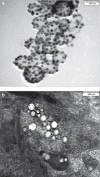
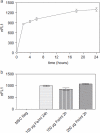
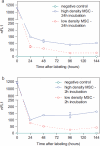
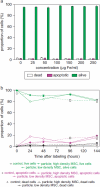


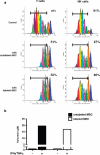
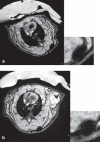
Similar articles
-
Iron Oxide Nanoparticles in Mesenchymal Stem Cell Detection and Therapy.Stem Cell Rev Rep. 2022 Oct;18(7):2234-2261. doi: 10.1007/s12015-022-10343-x. Epub 2022 Feb 1. Stem Cell Rev Rep. 2022. PMID: 35103937 Free PMC article. Review.
-
Efficient Labeling Of Mesenchymal Stem Cells For High Sensitivity Long-Term MRI Monitoring In Live Mice Brains.Int J Nanomedicine. 2020 Jan 8;15:97-114. doi: 10.2147/IJN.S211205. eCollection 2020. Int J Nanomedicine. 2020. PMID: 32021167 Free PMC article.
-
Mesenchymal stem cell labeling and in vitro MR characterization at 1.5 T of new SPIO contrast agent: Molday ION Rhodamine-B™.Contrast Media Mol Imaging. 2011 Jan-Feb;6(1):7-18. doi: 10.1002/cmmi.396. Epub 2010 Aug 5. Contrast Media Mol Imaging. 2011. PMID: 20690161 Free PMC article.
-
Design of iron oxide nanoparticles with different sizes and surface charges for simple and efficient labeling of mesenchymal stem cells.J Control Release. 2010 Mar 19;142(3):465-73. doi: 10.1016/j.jconrel.2009.11.014. Epub 2009 Nov 22. J Control Release. 2010. PMID: 19932720
-
Imaging modalities for the in vivo surveillance of mesenchymal stromal cells.J Tissue Eng Regen Med. 2015 Nov;9(11):1217-24. doi: 10.1002/term.1907. Epub 2014 Jun 11. J Tissue Eng Regen Med. 2015. PMID: 24917526 Review.
Cited by
-
Iron Oxide Nanoparticles in Mesenchymal Stem Cell Detection and Therapy.Stem Cell Rev Rep. 2022 Oct;18(7):2234-2261. doi: 10.1007/s12015-022-10343-x. Epub 2022 Feb 1. Stem Cell Rev Rep. 2022. PMID: 35103937 Free PMC article. Review.
-
Internalization of nanopolymeric tracers does not alter characteristics of placental cells.J Cell Mol Med. 2016 Jun;20(6):1036-48. doi: 10.1111/jcmm.12820. Epub 2016 Mar 14. J Cell Mol Med. 2016. PMID: 26987908 Free PMC article.
-
Development of a simple procedure for the treatment of femoral head osteonecrosis with intra-osseous injection of bone marrow mesenchymal stromal cells: study of their biodistribution in the early time points after injection.Stem Cell Res Ther. 2015 Apr 13;6(1):68. doi: 10.1186/s13287-015-0036-y. Stem Cell Res Ther. 2015. PMID: 25889681 Free PMC article.
-
Bone Marrow-Derived Mesenchymal Stem Cell Potential Regression of Dysplasia Associating Experimental Liver Fibrosis in Albino Rats.Biomed Res Int. 2019 Nov 6;2019:5376165. doi: 10.1155/2019/5376165. eCollection 2019. Biomed Res Int. 2019. PMID: 31781620 Free PMC article.
-
Imaging the intracellular degradation of biodegradable polymer nanoparticles.Beilstein J Nanotechnol. 2014 Oct 29;5:1905-17. doi: 10.3762/bjnano.5.201. eCollection 2014. Beilstein J Nanotechnol. 2014. PMID: 25383302 Free PMC article.
References
-
- Pittenger MF, Mackay AM, Beck SC, Jaiswal RK, Douglas R, et al. Multilineage potential of adult human mesenchymal stem cells. Science. 1999;284:143–7. - PubMed
-
- Sensebe L, Krampera M, Schrezenmeier H, Bourin P, Giordano R. Mesenchymal stem cells for clinical application. Vox Sang. 2009;98:93–107. - PubMed
-
- Abdallah BM, Kassem M. The use of mesenchymal (skel etal) stem cells for treatment of degenerative diseases: current status and future perspectives. J Cell Physiol. 2009;218:9–12. - PubMed
-
- Aggarwal S, Pittenger MF. Human mesenchymal stem cells modulate allogeneic immune cell responses. Blood. 2005;105:1815–22. - PubMed
Publication types
MeSH terms
Substances
LinkOut - more resources
Full Text Sources
Medical

